Jeff Chen
I wanted to share some tips for mounting tubeless tires that I've learned from doing 4 tire comparison tests and mounting over 60 tires over the last year and a half:
Warnings:
Installation Process:
Clean the rim bed with alcohol to remove any trace of oil or grease. Tape tubeless-ready rims with tubeless tape and install valves onto the rim. Be as careful as you can to tape rims securely as losing air through improperly installed tape seems to be the most common cause of tubeless setups not being able to maintain tire pressure.
Check the tire for markings that indicate direction of rotation before installing.
Install the tire bead on one side of the tire onto the rim.
Install the other tire bead ending at the valve. (The valve tends to allow less room for a tire bead leading to a tighter fit if you end away from the valve.)
[If you only have a floor pump] Try to inflate the tire. If you can get the tire beads to form some level of seal with the rim bed, you'll be able to get the tire to hold air. From that point keep pumping fast(!) up to 35 psi. You'll generally hear a 'snap' as the tire beads seat at about 35 psi. I don't recommend going above 40 psi to reduce the risk of tire and/or bead blowouts. I've found that about 1/4 to 1/2 of tires install easily with just a floor pump.
See tips and tricks below for ways to help the bead seat with just a floor pump
See below for the tire brand/rim brand combinations that I've found install easier
Warning: Be VERY careful not to exceed 40 psi in the tire to reduce the risk of tire and/or bead blowouts.
[If you have access to a compressor or gas station air hose] The process of installing tubeless tires is a LOT easier with access to a compressor. The high pressure that a compressor can deliver quicker than a hand pump helps force tubeless tire beads against a rim bed from which you can then add air up to the tire pressure at which the tire beads will seat (about 35 psi).
The high pressure that a compressor can deliver quicker than a hand pump helps force tubeless tire beads against a rim bed from which you can then add air up to the tire pressure at which the tire beads will seat (about 35 psi).
Warning: Be VERY careful not to exceed 40 psi in the tire to reduce the risk of tire and/or bead blowouts.
Congratulations if you are up to this point. Getting the beads seated is the most challenging part of this process. To complete the installation you need to add sealant into the tire & distribute the sealant around the sidewalls of the tire.
Let the air out of the tire. Generally the tire beads will remain seated on the rim.
Remove the tire valve core. Generally tubeless valves will be of the presta variety, not the schraeder valves that are typically used with car tires)This is the top part of the presta valve that screws into the larger diameter base of the valve.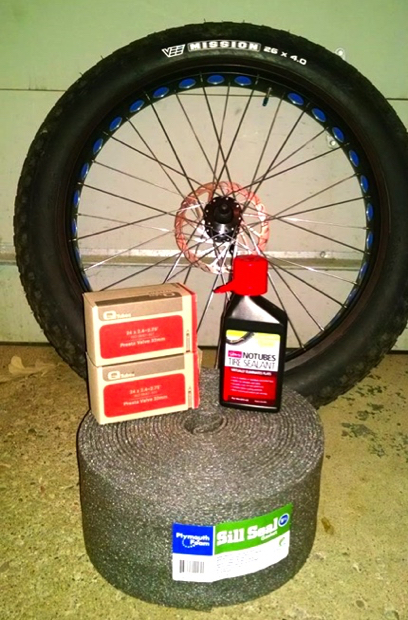 You can do this by using a core removal tool such as the Stans NoTubes Core Remover Tool or an adjustable wrench if you don't have a core removal tool.
You can do this by using a core removal tool such as the Stans NoTubes Core Remover Tool or an adjustable wrench if you don't have a core removal tool.
Inject about 4 oz of tubeless sealant into the tire through the tire valve with the valve core removed
Reinstall the valve core
Pump up the tire to about 35 psi
Shake the wheel/tire laterally to distribute sealant onto the tire sidewalls. Rotate the wheel/tire as you continue to do this around the entire tire.
Rotate the wheel/tire held horizontally to allow sealant to work its way into the junction between tire bead & rim. Set the wheel/tire down horizontally for 5-10 minutes. A cardboard box is a good way to keep the wheel/tire level. Flip the wheel over to the other side and repeat this process. Losing air due to tire beads not being adequately sealed against a rim is another common cause of tubeless setups not being able to hold pressure.
Adjust tire pressure based on your weight. This is a formula from Stans NoTubes that provides a starting point for matching tire pressure to your weight:
This is a formula from Stans NoTubes that provides a starting point for matching tire pressure to your weight:
Rider weight / 7 = X
Front pressure = X -1 psi
Rear pressure = X -2 psi
Example based on a rider weight (with gear) of 160 lbs
160 lbs / 7 = 22.9
Front pressure = 22.9 - 1 = about 22 psi
Rear pressure = 22.9 + 2 = about 25 psi
Tips & Tricks:
Use rims designed for tubeless use: Tubeless rims have a ridge next to the bead seat that will help to "lock" a tubeless tire's bead onto the rim after it is seated. I personally will not do tubeless "conversions" with non-tubeless rims. Non-tubeless rims that don't have the ridge to help lock in a tubeless tire's bead greatly increase the risk of burping (losing air in hard cornering) or rolling a tire off in corners.
Use tires designed for tubeless use: Tires designed for tubeless mounting have a casing that is more likely to be air tight as well as tighter fitting beads (keep reading for the benefits of tighter fitting beads for ease of tubeless installation).
Seat the tire beads before adding sealant: Trying to seat a tire that already has sealant added just adds potential for messiness. The sealant does not help the initial bead seating process.
Seating the tire beads with just a floor pump: If a tire's bead fit snugly against the rim bed, you have a good chance of being able to just use a floor pump to get enough air pressure to seat the beads. An air tight seal between bead and rim allows you to gradually build up enough air pressure in the tire until the beads seat around 35-40 psi.
Tricks for seating tire beads when a tire doesn't start holding air pressure immediately:
Make sure the tire is covering the valve hole
Try to move the tire so that the beads press against the rim bed
Use an inner tube to strap the tire against the rim
Seating the bead without a compressor: A inexpensive way to get a high volume of air into a tire at high velocity is to use a gas station air compressor. If you have Presta valve, you will need a presta-to-schrader valve adaptor such as the Slime 23042 Presta to Schrader Valve Adapter. The high velocity of air that is delivered by this method or with a compressor pushes the tire beads against the rim allowing pressure to build up to seat the beads.
If you have Presta valve, you will need a presta-to-schrader valve adaptor such as the Slime 23042 Presta to Schrader Valve Adapter. The high velocity of air that is delivered by this method or with a compressor pushes the tire beads against the rim allowing pressure to build up to seat the beads.
Add sealant via a tubeless valve that has a removable valve core: Many instructional videos will recommend removing one side of the bead at this time to add sealant. I don't agree with this approach. You've done a lot of work at this point to get both tire beads seated properly. Why would you want to undo part of the work you've done to seat the beads? Adding sealant through the valve core is by far the lowest effort way to add sealant.
For really hard to seat tires, pulling the tire bead on top of the rim could be worth trying: I just learned this new method of getting a better seal between tire and rim to do the initial inflation & seating of the bead if you don’t have access to a compressor or tubeless charger pumps that can deliver a high volume blast of air.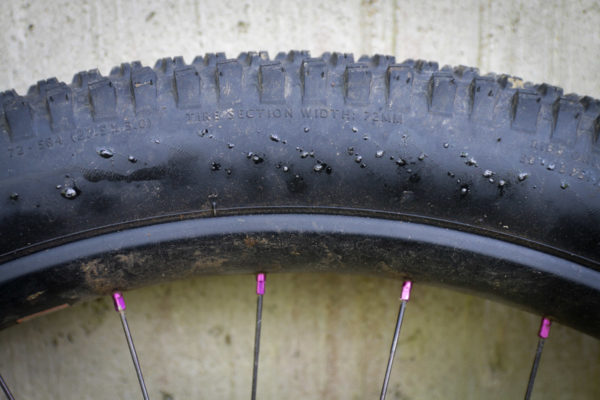 The basis of this technique is that you pull the tire bead on top of the rim with a tire lever. When you get to about 40-50% of the tire bead resting on top of the rim. you put your thumb on the tire bead so it doesn’t slip off of the rim and gently pull out the tire lever. Repeat on the other side and pull the bead up on the rim as far as you can go. Proceed to inflate the tire. Once you are able to get some pressure in the tire. There seems to be at least some risk of having the tire bead blow off the rim when you inflate the tire, so be aware of that and try this technique at your own risk. You can see the technique being used at: https://youtu.be/tE3h5nmDdOo.
The basis of this technique is that you pull the tire bead on top of the rim with a tire lever. When you get to about 40-50% of the tire bead resting on top of the rim. you put your thumb on the tire bead so it doesn’t slip off of the rim and gently pull out the tire lever. Repeat on the other side and pull the bead up on the rim as far as you can go. Proceed to inflate the tire. Once you are able to get some pressure in the tire. There seems to be at least some risk of having the tire bead blow off the rim when you inflate the tire, so be aware of that and try this technique at your own risk. You can see the technique being used at: https://youtu.be/tE3h5nmDdOo.
Easier to install tire brand/rim brand combinations
On Stans rims (Easton & DT rims have a similar diameter. Mavic & WTB have a slightly smaller diameter)
Schwalbe Snakeskin - Easiest
Maxxis Exo - Fairly Easy
Specialized 2Bliss - Fairly Easy
Continental Protection - Difficult to do initial seating of the beads on Stans rims
WTB TCS - CAN work but beads may be tight as the bead diameter is based on the tighter UST bead specification. I have mounted 2 WTB tires on Stans rims, but have heard that others have had challenges with this. Works better on WTB and Mavic rims.
I have mounted 2 WTB tires on Stans rims, but have heard that others have had challenges with this. Works better on WTB and Mavic rims.
Michelin, Hutchinson - I don't have direct experience but I believe these brands will work better on WTB and Mavic rims.
This is a great video on installing difficult-to-mount tubeless tires:
You can help support Dirt Merchant Bikes’ product testing by purchasing through our retail partners.
Orange Seal Tubeless Sealant
Our experience is that Orange Seal seals punctures quickly and consistently. The amount of rain we get in the PNW makes sealants drying out less of an issue, but Orange Seal also resists water absorption well.
Stan’s Tubeless Rim Tape
Stan’s tape has a little stretch that helps in removing air bubbles when taping rims.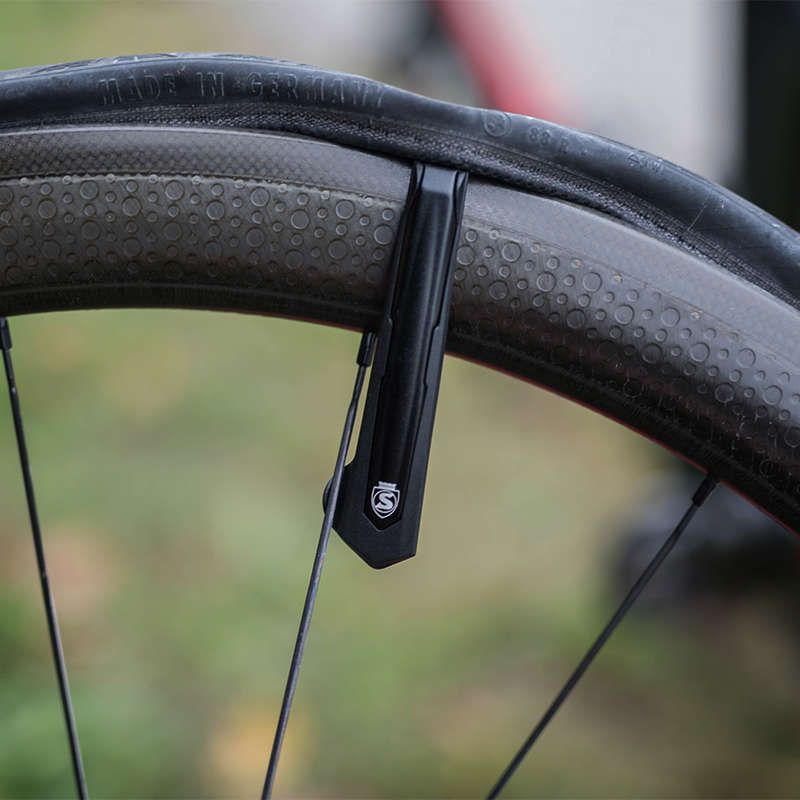 It sticks well to most alloy rims and some carbon rims. It also removes cleanly unlike Gorilla Tape.
It sticks well to most alloy rims and some carbon rims. It also removes cleanly unlike Gorilla Tape.
Stan’s Tubeless Valve Stems
Stan’s valves have a solid rubber base that helps reduce air leaks around the valve base. Tightening the locknut helps seal tape against the rim.
Diamondback Steel Core Tire Levers
It can be helpful to use a tire lever to get the last part of a tire bead onto a rim. Plastic tire levers don’t last long with that type of abuse. I like these better than the more expensive Park Tool TL-6. 2 Steel Core Tire Levers because the entire tip of the lever is covered in plastic to reduce the chance of scratching a rim.
2 Steel Core Tire Levers because the entire tip of the lever is covered in plastic to reduce the chance of scratching a rim.
Orange Seal Sealant - 16 oz Refill bottle
Orange Seal Sealant - 32 oz Refill bottle
Stan’s No Tubes Rim Tape 60 Yards x 30mm
Stan’s No Tubes Rim Tape 60 Yards x 27mm
Stan’s No Tubes Rim Tape 60 Yards x 25mm
InTires TagsTires
Outside's long reads email newsletter features our strongest writing, most ambitious reporting, and award-winning storytelling about the outdoors. Sign up today.
You’re railing that descent, nailing every line and feeling like a world champ, when suddenly you smash a wheel into a big square-edge rock.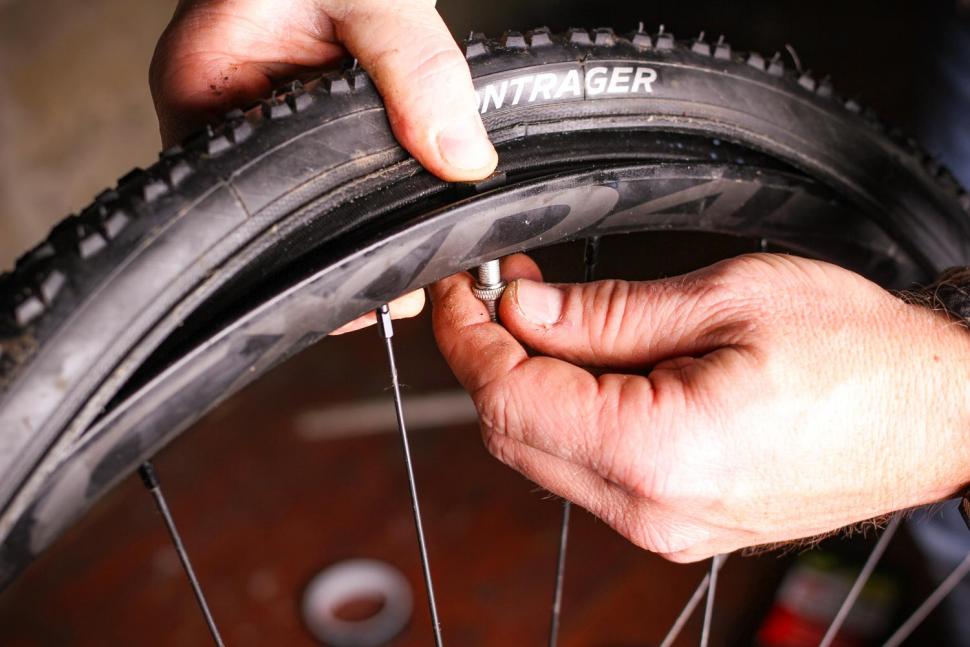 Quite literally, you can feel the air go out of the ride. Not much kills the stoke from a great spin quicker than a flat tire. This is why tubeless tires are increasingly popular for all kinds of cycling. These setups use a liquid sealant instead of an inner tube to hold air. As a result, they offer better protection against all kinds of flats and enable you to run lower pressures than tube-type systems, increasing traction and creating a more comfortable ride. In the event you do get a puncture, tubeless tires are also more likely to stay attached to the rim, which is safer.
Quite literally, you can feel the air go out of the ride. Not much kills the stoke from a great spin quicker than a flat tire. This is why tubeless tires are increasingly popular for all kinds of cycling. These setups use a liquid sealant instead of an inner tube to hold air. As a result, they offer better protection against all kinds of flats and enable you to run lower pressures than tube-type systems, increasing traction and creating a more comfortable ride. In the event you do get a puncture, tubeless tires are also more likely to stay attached to the rim, which is safer.
But ask most riders about going tubeless and you’ll encounter a litany of horror stories about setup. Why are some tubeless installs easy and others a multi-hour thrash session punctuated by merchant-marine levels of cursing? In short: manufacturing standards and tolerances. Wheels and tires from different brands vary ever so slightly in actual size, so a tire that fits great on one wheel is an overly tight nightmare on another. The good news is that this is slowly improving. Because manufacturing standards are getting better, with stricter tolerances, it’s now much more likely than even five years ago that you’ll be able to install and seat tubeless tires on the first try with a standard floor pump. Here’s a step-by-step guide.
The good news is that this is slowly improving. Because manufacturing standards are getting better, with stricter tolerances, it’s now much more likely than even five years ago that you’ll be able to install and seat tubeless tires on the first try with a standard floor pump. Here’s a step-by-step guide.
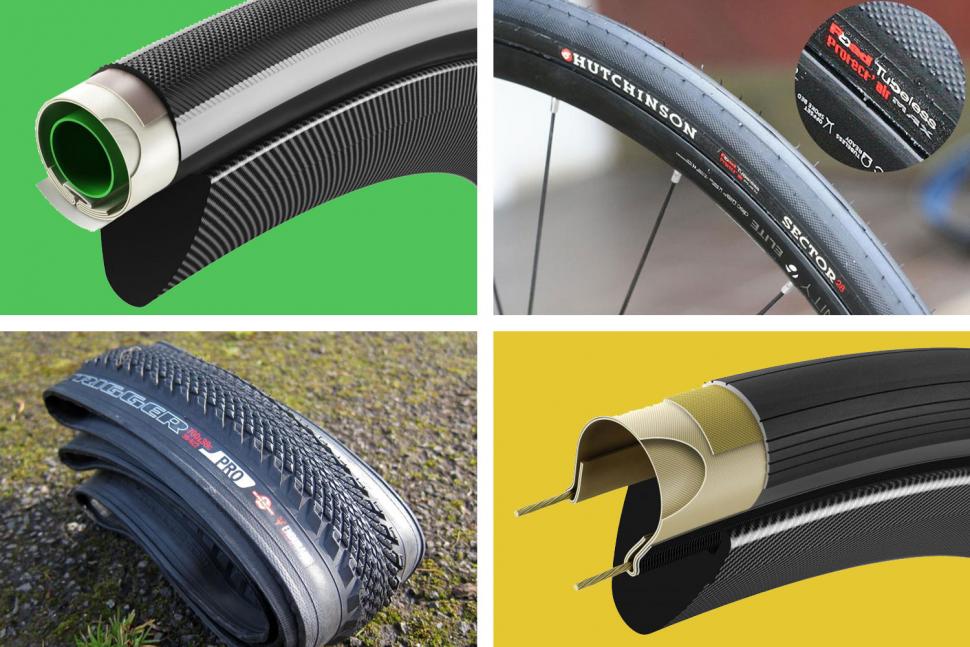 The bump prevents the bead from blowing off under pressure, and it reduces the likelihood that it can come loose if the tire goes flat.
The bump prevents the bead from blowing off under pressure, and it reduces the likelihood that it can come loose if the tire goes flat.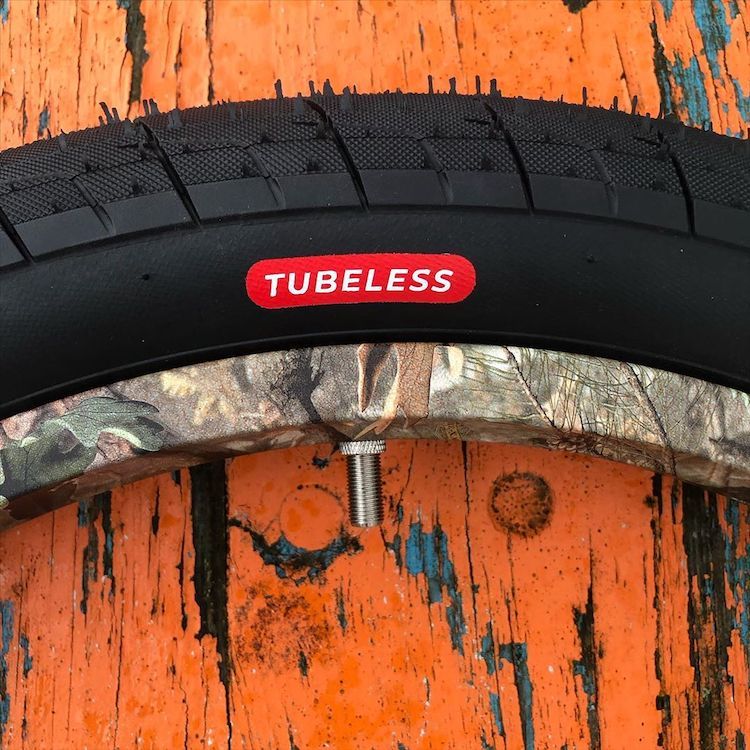
You’ll need tubeless-compatible or tubeless-ready wheels to start. This is governed by the rim profile itself (see the glossary, above). Most gravel and mountain-bike wheels these days are compatible; road bikes are not always so. But in any case, check manufacturer specs.
A warning: Do not under any circumstances try to make a wheel that is not listed as tubeless compatible into a tubeless system. If you’re lucky, all that will happen is the tire will blow off the rim in your garage and spray sealant everywhere. If you’re not lucky, the tire will hold just long enough for you to go on a ride, and then it will blow off, likely causing a crash. The same goes for tires: the bead on non-tubeless-ready tires will not hold securely in the bead lock and can blow off without warning.
Many higher-end wheelsets are tubeless ready right out of the box. For others listed as tubeless compatible, you’ll need to seal the rim bed (namely the spoke holes) with airtight tape. Good brands are Silca, Stan’s NoTubes, and WTB. You’ll need to match the tape width to your rim width.
This special elixir typically features very small solid particles of rubber or latex in a liquid suspension. When you’re riding, the particles slosh around the inside of the tire, where they find and plug small leaks. Good bets are Muc-Off, Orange Seal, and Stan’s. Buy an 8-to-16-ounce bottle. Sealant doesn’t dry out in the bottle over time like it does in tires, and you may want some extra in case the initial installation doesn’t go smoothly. Some bottles of sealant come with a measuring cup; if yours doesn’t, you’ll need a cup that has measurement markings in ounces.
Tubeless tires use special valve stems that create an airtight seal on the inside of the rim bed to prevent air loss. The rubber grommet that forms the seal sometimes has to be matched to the profile of your wheel’s rim bed (so-called universal valves claim to work with almost any system). The best valves have removable cores. Industry Nine, Muc-Off, and Stan’s make good universal valves with removable cores.
The rubber grommet that forms the seal sometimes has to be matched to the profile of your wheel’s rim bed (so-called universal valves claim to work with almost any system). The best valves have removable cores. Industry Nine, Muc-Off, and Stan’s make good universal valves with removable cores.
The sealant’s job is to plug holes, but it won’t seal a non-tubeless tire. More important: non-tubeless tires don’t have the specially shaped bead to lock to the rim. We’ll steer clear of recommendations here. Tires are personal and, for gravel and mountain-bike riding especially, the best choices are highly geography- and conditions-specific. Ask around for what others in your area use and trust.
You’ll need a floor pump, sturdy plastic tire levers, a valve-core remover (a very small and inexpensive wrench), a clean rag, a small paintbrush, some rubbing alcohol, and an old cup for soapy water.
These are big syringe-like devices that install the sealant directly through the valve stem.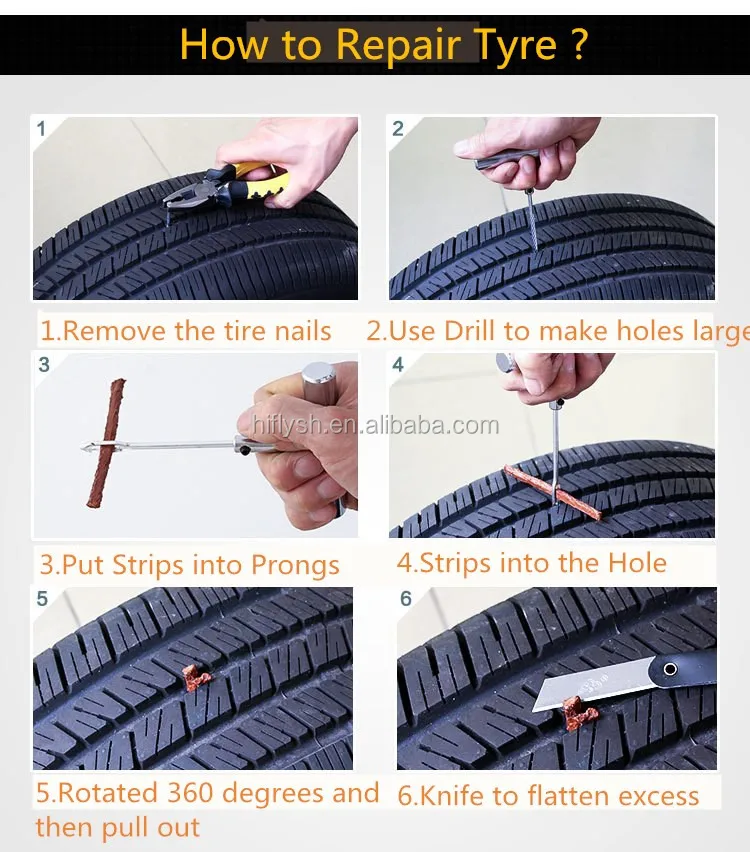 They’re fairly affordable ($10 to $30) and long-lasting. They’re also easy to use and much less likely to spill than the simple plastic measuring cup that comes with most bottles of sealant. Some have a needlelike attachment that can also be used to pull sealant back out of tires—useful if you’re swapping tires or want to store a bike for winter without letting the sealant congeal. Stan’s makes a basic system, but I prefer the KOM or Mil-Kit versions (note: Mil-Kit’s system is more expensive but comes with universal valve stems).
They’re fairly affordable ($10 to $30) and long-lasting. They’re also easy to use and much less likely to spill than the simple plastic measuring cup that comes with most bottles of sealant. Some have a needlelike attachment that can also be used to pull sealant back out of tires—useful if you’re swapping tires or want to store a bike for winter without letting the sealant congeal. Stan’s makes a basic system, but I prefer the KOM or Mil-Kit versions (note: Mil-Kit’s system is more expensive but comes with universal valve stems).
These are basically reusable air chambers that you pressurize with a floor pump, then place over the valve stem and use to inflate the tire quickly. They’re helpful because seating tubeless tire beads to the rim often requires a high volume of air delivered fast, and floor pumps can struggle to do that. Brands include Airshot, Mil-Kit, and Specialized. But these items are designed for one task only, which may not justify the price ($50 to $100) if you use them rarely.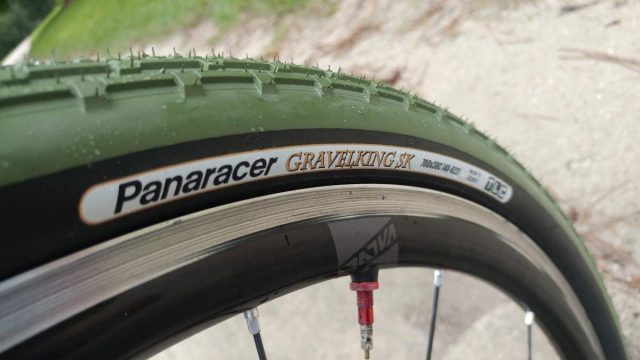 If you’re only installing tubeless tires on rare occasions, you can also use a conventional CO2 inflator system to seat beads. Many people use standard air compressors of the sort you need for home-improvement projects.
If you’re only installing tubeless tires on rare occasions, you can also use a conventional CO2 inflator system to seat beads. Many people use standard air compressors of the sort you need for home-improvement projects.
Tools: Rag, rubbing alcohol
Whether you’re working with new wheels or ones you’re converting, make sure they’re clean. Dip a rag in rubbing alcohol, and thoroughly wipe down the rim bed, rim tape, and internal sidewalls. Pay special attention to removing any debris from the bead hook, where the tire will seat. Check to ensure that the tape is even and tight, with no wrinkles or gaps that could leak air. Wipe dry.
Tools: Tire lever, floor pump, tube
That’s right: use a tube first. Why? It’s an easy way to get at least one of the tire beads firmly seated to the bead lock and to work out the kinks in a tire bead after it’s sat folded in storage.
Unfold the new tire, and seat one side in the rim bed. Many tires, especially mountain-bike tires, are directional or even front- or rear-specific; check to make sure it’s in the proper orientation before installing. Tip: line up the center of the tire logo over the valve stem, as this can make it easier to find and fix leaks on rides.
Inflate an inner tube just enough that it holds shape. Insert the valve in the rim’s valve hole, and tuck the tube into the tire. Finally, deflate the tube a bit, and install the other side of the tire. The bead will likely be tight in the last quarter or so. Use a tire lever, and carefully lift the bead into the rim well, taking care not to pinch the tube between the tire and rim. Once seated, push the tire bead toward the center of the rim bed, and visually check to make sure the tube isn’t pinched.
Inflate the tire, stopping at about 20 psi to make sure that the tire bead isn’t bulging out over the rim in any location. Resume pumping to a few psi short of the maximum inflation listed on the tire sidewall.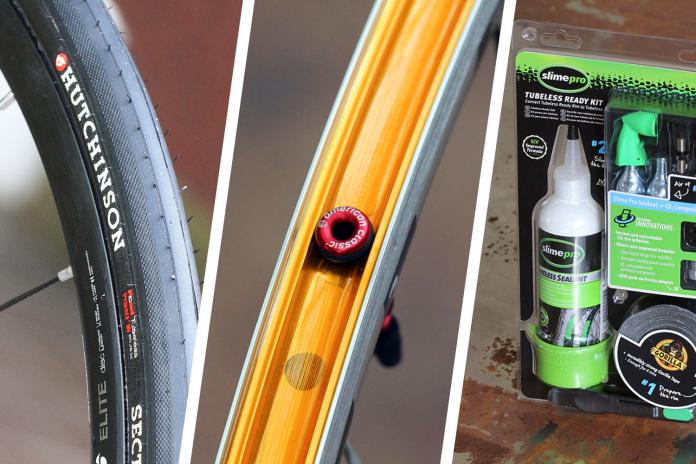 You’ll hear some snaps and pops. This is normal; it’s the tire bead seating in the rim lock. Finally, set the wheel in a warm, sunny location for 15 to 20 minutes. The heat softens the kinks in the tire bead, and—if you’re setting up wheels for tubeless for the first time—helps ensure that the rim tape’s adhesive is fully bonded to the rim and won’t leak.
You’ll hear some snaps and pops. This is normal; it’s the tire bead seating in the rim lock. Finally, set the wheel in a warm, sunny location for 15 to 20 minutes. The heat softens the kinks in the tire bead, and—if you’re setting up wheels for tubeless for the first time—helps ensure that the rim tape’s adhesive is fully bonded to the rim and won’t leak.
Tools: Tire lever
Take the wheel out of the sun, and let it cool back to room temperature. Deflate the tire. Carefully push only one side of the tire into the rim bed, then use the tire lever to lift that bead off the rim. Remove the tube, leaving the other tire bead seated in the rim.
Install the tubeless valve by threading the knurled nut as tightly as it’ll go with your fingers. Don’t use a wrench or pliers; overtightening could crack the rubber gasket on the valve stem and cause a leak.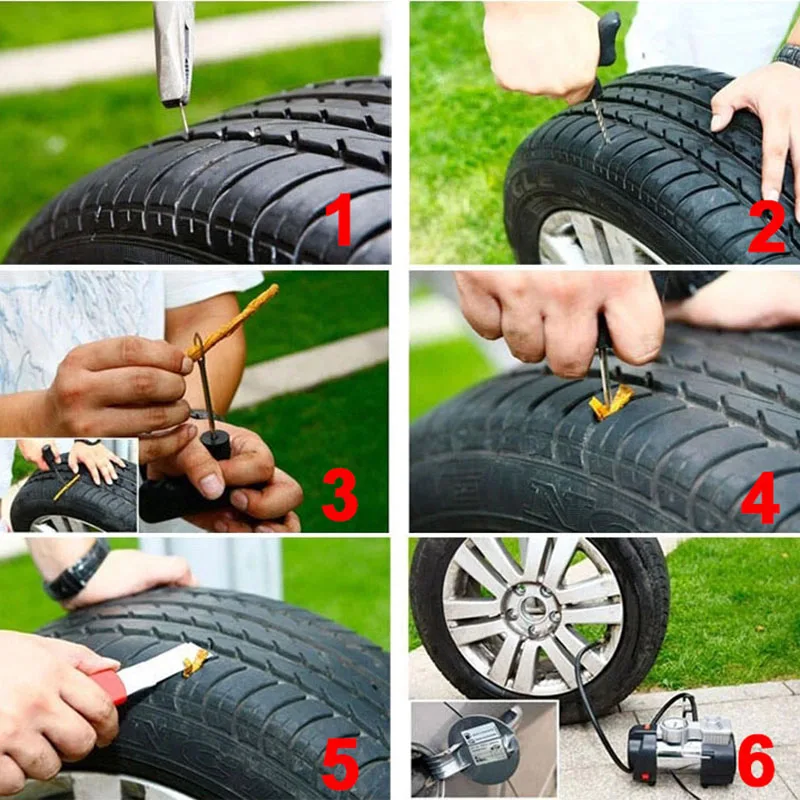 Make sure the valve you’re using fits the rim-bed profile (see “What to Buy,” above). A poor fit could leak.
Make sure the valve you’re using fits the rim-bed profile (see “What to Buy,” above). A poor fit could leak.
Tools: Tire lever, tire sealant, measuring cup or injector, valve-core remover
If you’re using a sealant-injector system: Reinstall the loose tire bead, taking care not to dislodge the bead on the other side of the tire. Use the valve-core remover to unthread the core counterclockwise, then remove it and set it aside. Shake the sealant bottle for 10 to 20 seconds to thoroughly mix its contents, then measure out the appropriate amount for your tire size into the injector chamber:
Two ounces for road tires (up to about 28 millimeters)
Three ounces for 700c gravel or 27.5 mountain tires
Three to four ounces for most 29er mountain tires
Five to six ounces for plus-size mountain-bike tires
Seat the injector securely on the valve stem (or push the needle fitting through the valve stem), and then carefully inject the sealant into the tire.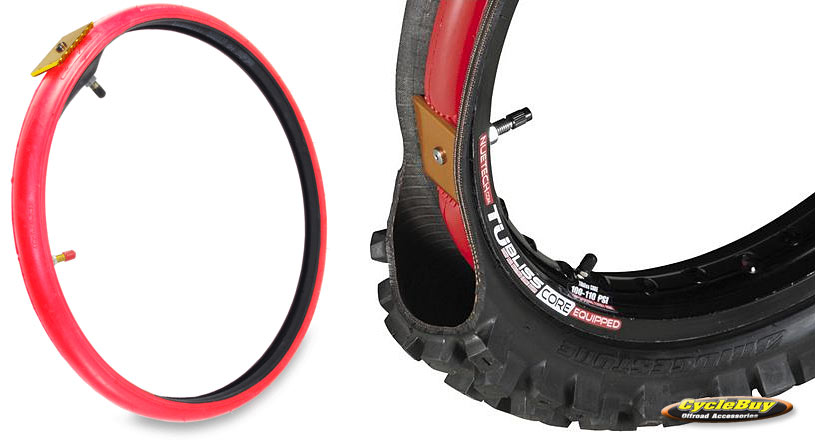 Reinstall the valve core.
Reinstall the valve core.
If you’re just using a sealant cup: Don’t worry about removing the valve core, since you’re not using it to add sealant. Reinstall the loose tire bead, but leave a final section unmounted. Prop up the wheel with this section closest to the ground but the opening tilted upward to prevent spillage. Shake the sealant bottle for 10 to 20 seconds to thoroughly mix its contents, then pour the appropriate amount into the cup, and carefully pour that directly into the tire at the unmounted section. Grab the wheel and gently rotate the unmounted section up to 12 o’clock, so that the sealant flows into a fully mounted section of the tire where it’s less likely to leak out, and wrestle the final section of tire bead onto the rim (you may need the tire lever).
Tools: Floor pump, soapy water, small paintbrush
Seating tubeless tires takes a lot of air rushing into the tire very fast to seat the tire bead into the rim lock. You might be able to do this with a floor pump, but you may need a higher-volume air source.
You might be able to do this with a floor pump, but you may need a higher-volume air source.
Take the paintbrush and dip it in the soapy water, then run it along the tire sidewall where the loose tire bead and rim bead lock meet. The soapy water helps the tire bead slip into place more easily.
If you’re using a floor pump: Because you’ve already seated one side of the bead, you may be able to inflate the tire with a floor pump. It takes some effort and maybe a little luck. First, thread the wheel skewer or axle through the hub—that provides something to grab as you spin the wheel to disperse sealant. Then firmly seat the pump chuck on the valve stem (making sure the stem core is fully open), and pump full strokes as fast as you can to get the installed but unseated tire bead into the rim’s bead lock. Again, you’ll hear those telltale snaps and pops. If you hear that, keep pumping! Pump to a few psi short of the maximum inflation listed on the tire sidewall. Quickly remove the pump chuck, grab the quick-release lever on the wheel skewer or axle, and spin the wheel for a minute or so, rotating the axis back and forth. This helps distribute the sealant evenly inside the tire. If you see sealant spraying out anywhere for more than a few seconds, stop; the tire’s not fully seated. Also: if you are pumping quickly for at least 30 seconds but the tire won’t hold any air, stop; the tire likely won’t seat with just a floor pump.
Quickly remove the pump chuck, grab the quick-release lever on the wheel skewer or axle, and spin the wheel for a minute or so, rotating the axis back and forth. This helps distribute the sealant evenly inside the tire. If you see sealant spraying out anywhere for more than a few seconds, stop; the tire’s not fully seated. Also: if you are pumping quickly for at least 30 seconds but the tire won’t hold any air, stop; the tire likely won’t seat with just a floor pump.
Secondary protocol: If you can’t get the tire bead to fully lock in the rim, you’ll need a higher volume of air delivered faster. This is where the CO2 cartridge inflator you normally use for trailside-flat repairs comes in or the special tubeless-inflation systems we mentioned above. Another option is a pump with integrated booster chambers, like the Bontrager TLR Flash Charger or the Topeak JoeBlow Booster, although these get mixed reviews.
In any case, the process is basically the same with a booster or combo pump: charge the booster chamber, securely fasten the inflator chuck around the valve stem, then release the air into the tire. If you’re using a CO2 inflator, use the largest cartridge you can find for mountain tires (up to 20 grams). If the CO2 cartridge successfully seats the bead, it may still not be at the full pressure needed to ensure a complete seal to the system. Remove the inflator, and switch to the floor pump, topping off the pressure to a little less than the listed maximum sidewall pressure.
If you’re using a CO2 inflator, use the largest cartridge you can find for mountain tires (up to 20 grams). If the CO2 cartridge successfully seats the bead, it may still not be at the full pressure needed to ensure a complete seal to the system. Remove the inflator, and switch to the floor pump, topping off the pressure to a little less than the listed maximum sidewall pressure.
Something to consider: stand-alone tubeless boosters cost $50 or more. Booster and pump combos cost $120. Pancake-style air compressors start at $99, plus $30 or so for a Presta attachment.
Whichever method you use, once the tire seats, grab the wheel by the quick-release or through-axle lever, and spin it to disperse the sealant inside. Success? Awesome. Check for obvious sealant leaks at the sidewall and valve stem. If you don’t see any, install the wheel on the bike, and ride slowly around the neighborhood—this helps the sealant foam and plug any microscopic hole in the system. Leave the tire inflated at the higher pressure, which helps ensure that the tire stays sealed.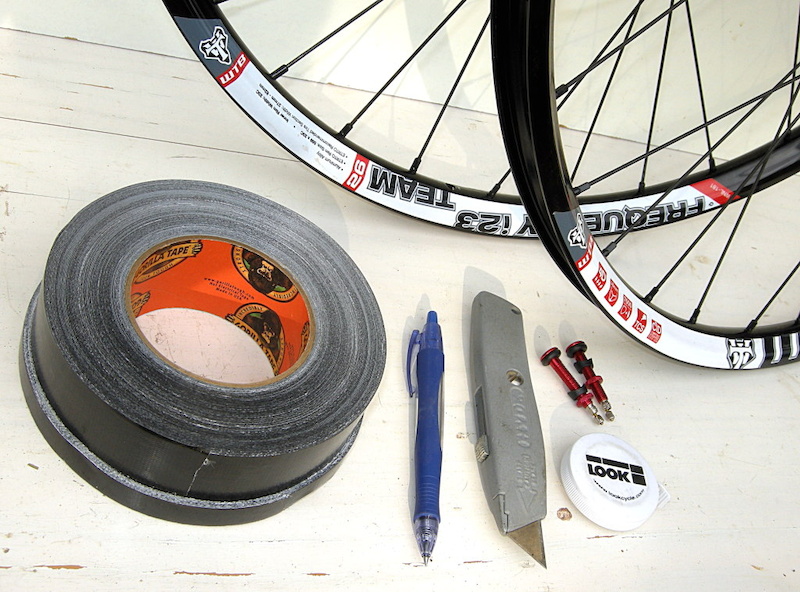
If this process didn’t work, the problem may not be something you can fix at home. In that case, we recommend going to a shop.
Many cyclists are used to the telltale hissing sound coming from tires. At any moment, your high-tech mountain bike can be put out of action by a simple thorn or a small piece of pebble.
Since the advent of pneumatic tires, this problem has haunted cyclists, tiring with the frequency of punctures and the amount of work needed to fix them. And only recently, bicycle tire and rim manufacturers have decided to create a universal tubeless system (UST).
This system is a sealed rim in which the holes for the spokes and the nipple are completely airtight. Also, the non-porous rim sidewalls have improved grip on tire walls that are thicker than conventional tires. During tire inflation, the air presses the tire bead (lower edge of the sidewall) into the corresponding groove in the rim flange, thereby sealing the contact between the tire and the rim.
Theoretically, the advantages of a tubeless tire include low weight (due to the lack of a tube, although tubeless tires are heavier than conventional tires), less pressure (providing better grip) and the absence of pinch punctures (also known as "snake bites"). If you add some sealant to the system, then penetrating punctures will also be a thing of the past.
But what about a cyclist with conventional rims without sealing? Just buy a conversion kit, tubeless or Tubeless Ready tires and he can send his bike tubes to the dustbin of history.
Of course, you can only add sealant to a conventional chamber. In this case, you won't gain any weight or grip advantage, just add a little weight to the wheels, but it will help you avoid punctures and not spend money on new tubeless tires and a tubeless conversion kit. Read our guide to using Gremetic in chambers.
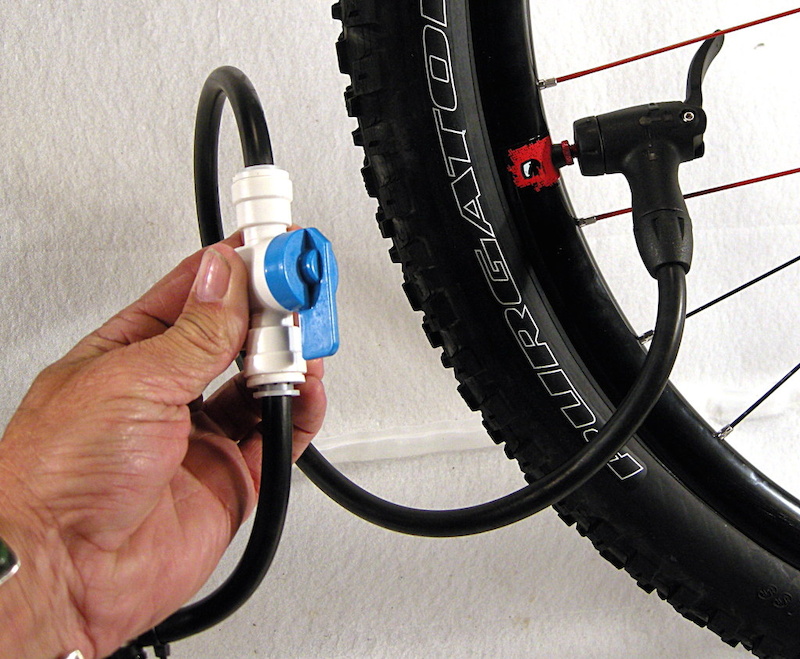
Remove the wheels, tires and tubes from the bike. If the wheels are old, greasy and dirty, clean them with hot soapy water or alcohol. The rubber tape will need to be taped to the spoke bed of the rim, so the rim needs to be clean and free of dirt so that the tape is snug against it.
Take the rim tape and unfold it so that the nipple is on the inside of the tape. Run your fingers around its circumference and check it for cuts, nicks, bulges, and proper molding that could cause air to leak. Even if the tire drops a few psi in a day, it can be very annoying.
Position the part of the rim tape with the nipple in the spoke bed, gently push the end of the nipple through the hole provided for it and pull it out the other side. The piece of tape near the nipple is slightly thicker and therefore difficult to install correctly, but it is important to install it correctly now so that you do not have to look for the source of leaks later.
The piece of tape near the nipple is slightly thicker and therefore difficult to install correctly, but it is important to install it correctly now so that you do not have to look for the source of leaks later.
Next, you need to install the remaining section of the rim tape in the spoke bed. This is easier said than done as the tape is tight against the rim. The easiest way to install it is with a screwdriver with a long thin handle. Position the screwdriver perpendicular to the rim between the rim and the rim tape. Slowly moving the screwdriver around the circumference of the rim, set the rubber band evenly in the spoke bed.
First of all, make sure you have a working nipple that does not let air through. Most nipples have a special threaded lock washer that screws onto the nipple body. The nipple usually comes with a rubber o-ring that needs to be installed between the lock washer and the rim. By flattening the O-ring, you will create an additional seal on the outside of the hole.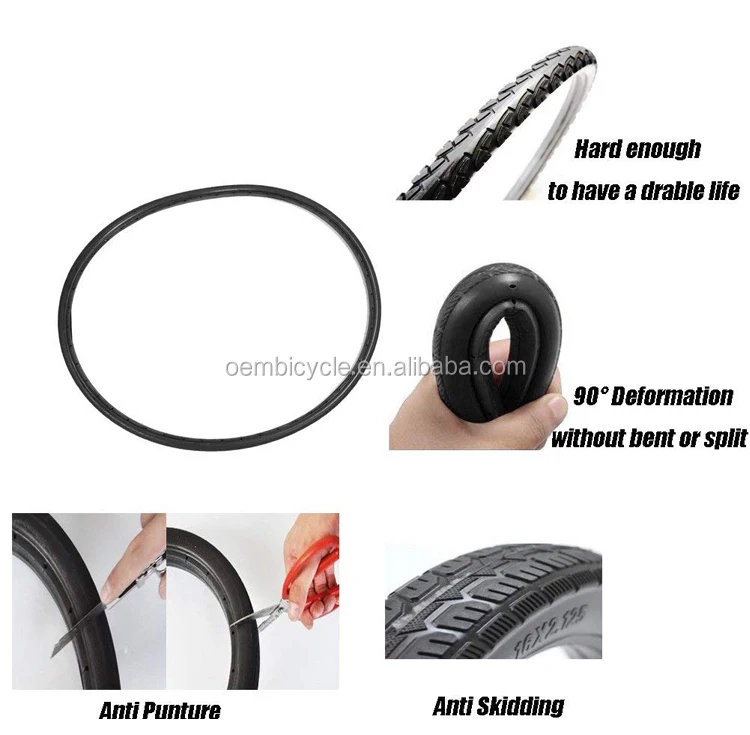
Now that the rubber rim is in place and lying in the center of the rim, you need to check the uniformity of its tension throughout the entire length of the rim. Air can leak between the rim and the rim tape if there are loose or tight areas on the tape. Again go around the rim with a screwdriver and equalize the tension of the tape. This will take a few minutes.
Tires from different manufacturers or even different models from the same manufacturer differ in installation complexity, quality and other characteristics. If the tires were not installed on the wheel, then first install them as usual with tubes, inflate to the maximum recommended pressure and leave them overnight. After that, they will be much easier to install and pump.
Place the wheel on your feet so that the nipple is at the highest point of the wheel (at 12 o'clock).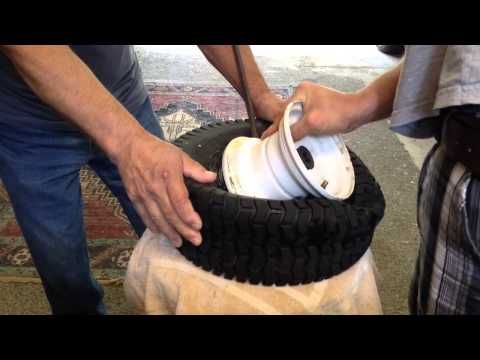 First, place the tire beads near the nipple, then walk with both hands around the circumference of the tire (in different directions), loosening the bead over the rim wall along the way. Once you get to the very bottom of the wheel, leave an 8-inch section.
First, place the tire beads near the nipple, then walk with both hands around the circumference of the tire (in different directions), loosening the bead over the rim wall along the way. Once you get to the very bottom of the wheel, leave an 8-inch section.
Some sealants can be applied without removing the nipple core, the spring-loaded piece that screws into the nipple body and allows air to enter the tire without escaping, but most cannot. Sludge Sealant can be injected without removing the core of the nipple. Removable core nipples are included in many conversion kits, but not all. The core must be unscrewed and removed. Be careful not to lose it as it can easily roll over furniture on the floor. If you have a nipple without a core to be removed, then immediately go to step 12.
Now that you have completely seated the tire on the rim and removed the core of the nipple, you can inject the required amount of sealant into the tire using the narrow line nozzle. Shake the sealant bottle well before doing this.
Shake the sealant bottle well before doing this.
After the sealant has been poured through the nipple, screw the nipple core back. Before screwing in the core, it is recommended to lubricate its threads with petroleum jelly, which will reduce the likelihood of jamming of the core or difficulty in turning it.
If you don't want to or can't apply sealant through the nipple, leave a small section of the tire bead exposed on the rim and pour sealant through it. Use a bottle with a nozzle to infuse the sealant, as a natural rubber tire is difficult to keep its shape. Suspend the wheel carefully so as not to spill the sealant from the tire.
To install the last section of the tire, carefully rotate the wheel so that the uninstalled section is on top. Now you can let the sealant spread all over the tire. Do not worry if a little sealant still leaks.
Start inflating the tires with the car pump until the tire beads press against the rim. When the pressure is too high (about 60 - 80 psi for UST tires and Tubeless Ready tires), the tire beads should click into place with a characteristic "clicking" sound. Be careful when handling this high pressure. Your tires are now tubeless.
Air can escape between the rim and tire. Raise the wheel, take it by the tire like you are holding a tray. Shake the wheel well so that the sealant spreads throughout the tire, reacts with the air and creates a thick sealing layer. Even if you skip this step, over time, the sealant will still spread on its own. Leave the wheel for 15 minutes, then repeat this step again. Air leakage should stop.
Hold the wheel up to your ears and listen carefully for air leaks. If a leak is found, then it is most likely a microscopic hole. Repeat step 15 and/or add more sealant.
The carcass of the UST tire is impregnated with special rubber to retain air. Tubeless Ready tires have thinner walls, which means they are lighter and less airtight.) They have a dockable bead needed to install them as tubeless. At the same time, Tubeless Ready tires can only be used as tubeless tires in conjunction with liquid sealant, but we still recommend buying UST tires. Theoretically, with the help of sealant, you can use both tubeless and conventional tires, but you can only install them correctly by trial and error.
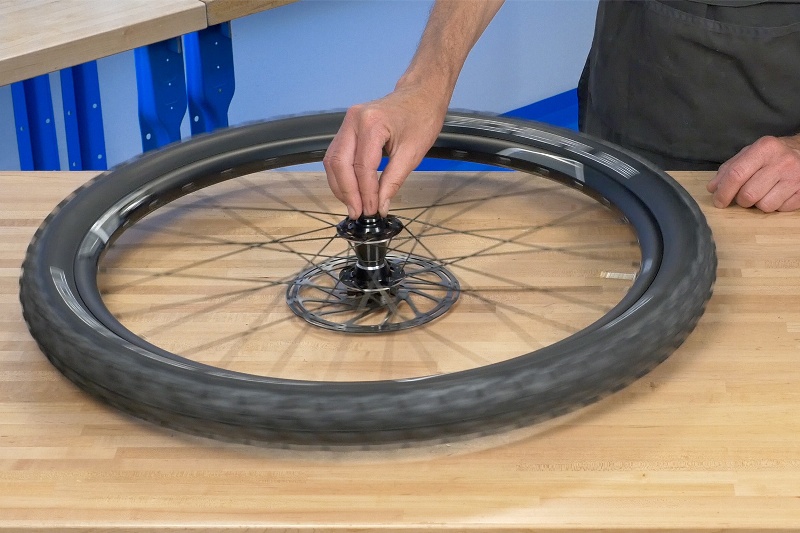 Inflate the tire to the recommended pressure.
Inflate the tire to the recommended pressure. Now I will campaign for tubeless wheels, which I consider the second great gift of bicycle marketers (the first gift is the transition to the 1x system, one star in front). I myself got to tubeless only last year, along with a return to the MTB theme.
Anyone who rides offroad more or less seriously and is still on cameras, I recommend that you carefully read the text below - only practice, only relevant info, no lyrics about UST wheels and ghetto tubeless. Perhaps I can convince you to look in that direction.
Well, the rest can also be found for development. This will only be about mountain bikes and hard off-road use, although there are also advances in this direction on the highway, but more on that another time.
Contents:
An advantage that is important for any rider, regardless of style and level of riding - you can forget about 95 percent of punctures. Any little thing, such as plant thorns, wire, small glasses, etc. sealed with sealant almost instantly. On chamber wheels, each such episode would turn into a seal / replacement of the camera.
Absolutely real picture
Ability to drive at low pressure. This point will be appreciated by cyclists who ride on a hard off-road, where there are a lot of stones, roots and loose dirt. A soft tire spreads over the surface, clinging to each tread cube, licks bumps, and it is extremely difficult to break it with a snake bite (but, of course, everything is possible if the pressure is too low - both the tire and the rim are crushed).
Therefore, to get the most out of tubeless, the tire pressure setting must be very accurate. Let's take a conditional wheel weighing 80 kg and a 2.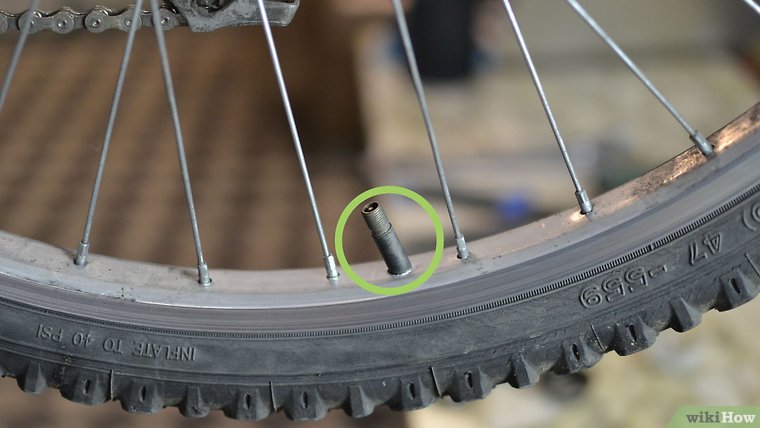 35 tire, with chambers it will have to fill at least 2 atmospheres, and with a tubeless wheel 1.5, or even less, will be enough. The difference in behavior on the ground will be enormous.
35 tire, with chambers it will have to fill at least 2 atmospheres, and with a tubeless wheel 1.5, or even less, will be enough. The difference in behavior on the ground will be enormous.
The next plus is better cushioning, less vibration, more comfort. It is possible to have a bike with excellent suspension, but low-pressure tires, especially large-volume ones, are the best to eat small things. For example, I now have a Schwalbe Nobby Nic 29 in front×2.60 and a Maxxis Agressor DD 29x2.50 in the back, my weight is within 100kg and I ride with pressure 14psi/21psi (0.97/1.45atm) - perfect. The grip is just crazy, the bike goes smoothly and rolls perfectly.
Tubeless wheels roll even better, and rolling resistance measurements do show some improvement over tubeless ones. Subjectively, it is difficult to feel, but in any case, the best roll forward, albeit a little bit, is not bad.
Well, the weight, where without it. Even with the sealant, on average, you can save up to 100g per wheel by eliminating tubes.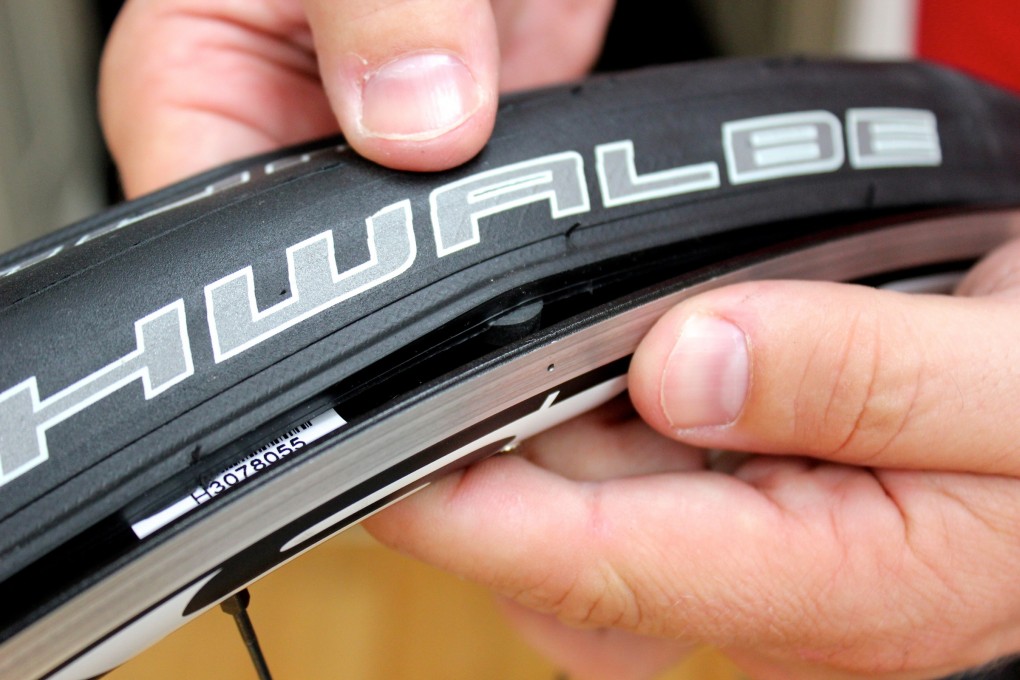
Let's start with the fact that tubeless tires are initially more of a hassle - to install them, you need special rims and tubeless ready tires, you need a special sealant, you need rim tape and nipples. And the installation process itself is not always simple and sometimes requires a compressor or booster.
Unrepairable outside the walls of the house or workshop. If you cut the tire badly and need to glue it from the inside, or it was torn off the rim due to too low pressure, then with a portable pump you will never put it back. There are two solutions to the problem: a CO2 cartridge with you, the pressure in which allows you to put a tubeless on a rim or a spare tube. Both options are good, I stick with the second.
It's expensive. If you have a simple bike or an old model, then its rims do not support the installation of tubeless, you need to buy new ones. The tubeless ready rubber itself is more expensive than the tubeless one, although lately almost all MTB tires in the most popular price range of 40-60 euros have been produced only in the tubeless version. Well, rim tape, nipples and sealant also cost money.
Well, rim tape, nipples and sealant also cost money.
The sealant tends to dry inside the tire and coat the inside of the tire with a thin adhesive layer. Because of this, about once every six months, you need to remove the tire and scrape out all the muck. You can not do this, but simply add new sealant slowly as it dries, but then a layer of dried sealant will grow (nothing to worry about).
An important factor is that the rim must fit the width of the tire. Here are the options if the dimensions don't match:
Narrow: pear-shaped profile, poor steering, increased rolling resistance, tire feels rolled (floats)
Correct contact patch, tread cubes in place. Minimum rolling resistance with maximum grip.
Wide: Vibration absorption deteriorates, side studs catch on the road in a straight line, poor steering
First, make sure your rims are ready for conversion. To do this, you can google the description of the rim model, it should be labeled tubeless ready, TR, TLR. You can make it easier - look at the profile of the rim, it should have small indentations near the walls that keep the tire from falling off at low pressure in a turn. When installing the tire, as it were, snaps into these grooves and holds firmly there.
To do this, you can google the description of the rim model, it should be labeled tubeless ready, TR, TLR. You can make it easier - look at the profile of the rim, it should have small indentations near the walls that keep the tire from falling off at low pressure in a turn. When installing the tire, as it were, snaps into these grooves and holds firmly there.
Rim tubeless ready
Unfortunately, stock bikes have only recently been fitted with such rims, and we are talking about models in the middle price segment and above.
You can fit tires tubeless and on a regular rim, but the lack of these seats will not allow you to take advantage of low-pressure riding - the tire will simply rip off with a strong side load. On the other hand, even one such important plus as puncture resistance is worth it to switch to tubeless and on a regular rim.
So, to install tubeless tires, you need to buy such nipples, sealant and rim tape .
The size of the tape should be taken a little less than the inner width of the rim, let's say the rim is 25i, so the tape will be 23mm, give or take.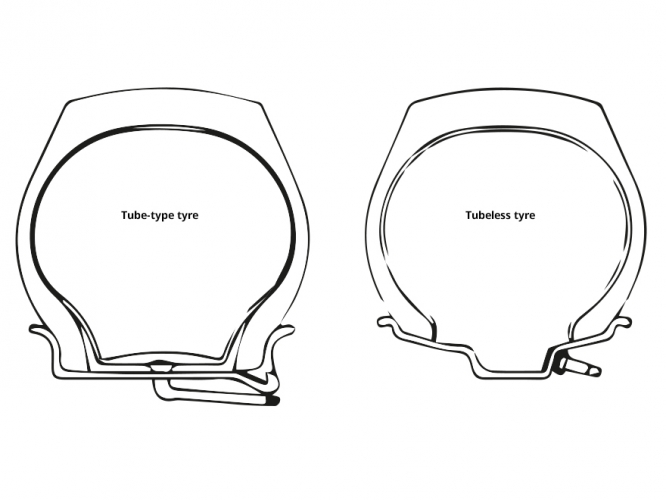
But here is a nuance, it is usually recommended the other way round, so that the tape is slightly wider than the rim, then due to the concave profile it will completely cover its entire width. At first I did this, but it turned out that when removed, the tire tore off the tape, jumping out of its seats. I bought tape already on the rim, to seal only the place where the spokes, and everything was fine.
Approximately 60 ml of sealant for one tire size 27.5x2.25, 473 ml cans will last for two seasons.
To put a tire on a rim, you must have either access to a compressor or a good floor pump (the latter does not guarantee success).
So, having prayed to the bicycle gods, we begin. We clean and degrease the inner surface of the rim, then glue the rim tape. You need to glue carefully, but with an interference fit, completely, the entire circumference, even with an overlap. One layer is enough. They pasted it, smoothed it with their fingers, made sure that the tape stood up evenly, without bubbles.
Now with something sharp, make a small cross cut at the hole for the nipple. We very carefully insert the nipple for tubeless tires into this cut and slowly push it through, put it in its place. We tighten the nut, confidently, but without fanaticism, it is not necessary that the sealing gum is deformed.
The job is almost done, it remains only to put the tire on the rim, but this is just the biggest problem if you do not have a compressor or booster. We do everything, as usual, first one side, then the second, preferably with bare hands, without the use of montages. If it doesn't fit, try my recommendation on how to put a stubborn tire on a rim.
If you have a compressor, then everything is simple - blow into the nipple, the tire will click into place and it's done. But if there is only a floor pump, then the chances of pumping up a tubeless wheel are 50/50. First you need to unscrew the core of the nipple (spool), with a special key or pliers, so that air enters the tire without resistance.
We turn on the pump, once again ask the mercy of heaven and begin to pump furiously. The harder you pump, the more air comes in, expanding the tire. With any luck, this will be enough and the bead cord of the tire will jump into its grooves on the rim. If not, then you swear and try to swing even more furiously. Most often, if the tire does not rise immediately, then it will not rise.
When I got tired of these exercises, I bought myself a booster - figuratively speaking, a bottle with a hose into which you can pump a lot of air by creating a pressure of 8-10 atmospheres. Then you connect this bottle to the nipple, open the valve, and watch with joy how the tire jumps into the right place.
Schwalbe booster is a useful item
An extremely useful booster item in the tubeless inventory. You can buy it, it costs between 40-50 euros. You can make it yourself, even from an old fire extinguisher, even from a 1.5l plastic bottle (google DIY tire booster). Also, if you do not already have a floor pump, you can buy a pump with an integrated booster, but it is quite expensive (like a regular floor stand and a booster separately).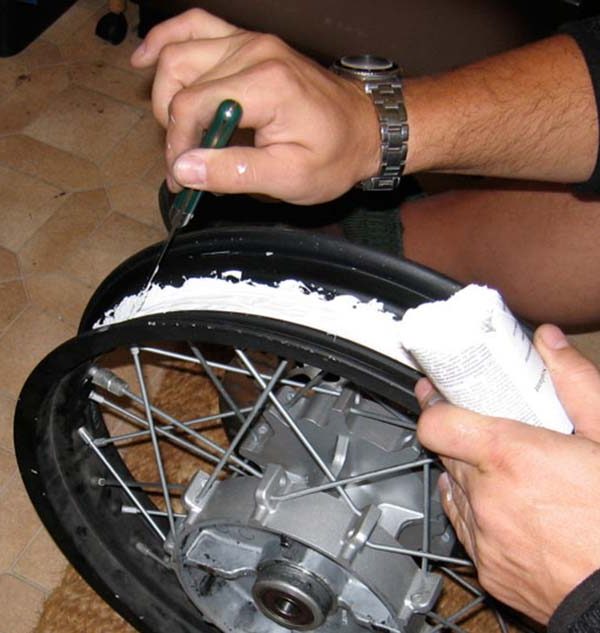
Now that the tire is in place, screw in the spool and inflate the wheel to its maximum pressure to see if it deflates. Usually, at this stage, if there is an air leak, it is because the rim tape has not adhered well or is torn in the area where the nipple is attached. Then you have to disassemble everything and re-glue the tape. But most often the pressure holds, you can fill in the sealant.
Unscrew the spool again, and pour "milk" directly through the nipple, as much as necessary (about 50 to 100 ml is needed, depending on the volume of the tire). There are measuring bottles, but you can fill it with a syringe.
Schwalbe Doc Blue Sealant - actually it's a regular Stan's Notubes, so you can safely buy
When the sealant is poured, it is necessary that it spreads on the inner surface of the tire, for this, spin the wheel on the axle, tap it on the floor. Sometimes you can immediately see that in some places the tires had micro holes, sealant begins to ooze out of them. It's all right, nothing to worry about. Screw in the spool, clog the working pressure and go for a ride - this is the best way to get the sealant to the right place.
It's all right, nothing to worry about. Screw in the spool, clog the working pressure and go for a ride - this is the best way to get the sealant to the right place.
If what you read seems like a complex operation, it is actually very simple, taking about half an hour if for the first time. For visualization, here is a video for you on how to put a tubeless tire on a bicycle:
I deliberately did not touch on the topic of ghetto tubeless, this is when ordinary rubber is put on a regular rim. This topic itself is dubious, but if you have such a need, just google this phrase.
Sealants are different, at least four or five well-known brands make "milk", they have slightly different properties. Two main requirements: to quickly seal the punctures and not dry out for a long time.
Two main requirements: to quickly seal the punctures and not dry out for a long time.
I read somewhere a comparison of all the main sealants and there I came to the conclusion that these two claims are poorly compatible: either it does not dry, or it glues well. Therefore, most tubeless bikers use the old, trusted Stan's Notubes (or Schwalbe Doc Blue, which is the same). It dries up and every two or three months you need to add a little, but these are the costs of technology.
He glues all the little things instantly, cuts, of course, are worse, but also not bad. There is also a recipe for adding decorative glitter to the sealant to thicken the consistency and improve the sealing speed, but for me personally, what I have is enough.
How many atmospheres to fill is determined empirically. I take a small gauge with me on the trail and start riding, gradually reducing the pressure until I feel good in terms of smoothness, and in terms of grip, and in terms of overrunning. As soon as the roll has fallen and the tire has begun to "float" - stop, return to the previous level. It's simple, experiment once and then stick to these values.
As soon as the roll has fallen and the tire has begun to "float" - stop, return to the previous level. It's simple, experiment once and then stick to these values.
Before I started using tubeless bikes, my bike had some average pressure for all roads. Now, before I leave the house, I inflate tires for a specific style of the current ride. Since I ride aggressively on hard rocky trails most of the time, I have an MTB setup, as I wrote earlier - 14/21psi, but if I'm going to roll far on asphalt, I stuff 20/28psi. Already very different behavior of tires at different pressures, I want to squeeze the maximum.
Riding a bike, you are pierced by something small, and on the go it is not even noticeable, you are driving, but it is just stuck. When something is more serious, and you can hear the “milk” hissing and splashing, it’s better to stop. First you need to lower the puncture site down so that the sealant penetrates well into the hole, and then start rotating the wheel.
The gluing process is similar to clot formation, contacting with air, the sealant particles become thick, new particles are deposited on them and a layer of hardened sealant grows at the puncture site from the inside. When the air has stopped oozing, you can pump up the wheel to restore pressure and drive on. The whole operation usually takes a minute or two. Compare how much it takes to change a camera.
In 95% of cases, self-sealing a tire is quick and painless, but sometimes there is a large cut or tear, then the sealant simply cannot cope. In the field, such a nuisance is difficult to eliminate. There are special patches that look like fungi for car tubes, but I have not personally used them and have heard mixed reviews.
If you find yourself in the described situation, then you need to be prepared for this. Some carry the usual camera patches and CO2 cartridges. They seal the cut from the inside, then use a spray can to bead the tire, pump it up to working pressure and move on. This option is so-so, because on rocky trails you can tear the sidewall of the tire and most likely no fungus will help. You need to darn with a needle and thread, and then glue the patch from the inside.
This option is so-so, because on rocky trails you can tear the sidewall of the tire and most likely no fungus will help. You need to darn with a needle and thread, and then glue the patch from the inside.
Therefore, I get by with a spare tube, if such a misfortune happens, then I simply disassemble the tire, unscrew the tubeless nipple, and put the tube, having previously poured out the sealant. There is only one caveat - the tire, most likely, already carries a lot of small thorns, wires and other muck, which is enough on the roads. If you immediately put the camera, then most likely it will immediately pierce from the inside. Therefore, you must first carefully probe the inner surface with your hands and pull out all the sharp rubbish sticking out.
Based on this, the conventional wisdom that tubeless is not good for travel is a myth. Firstly, it is not so easy to ruin the tire so much, and secondly, you can temporarily roll back to the camera without any problems. But you get an almost complete absence of trouble with punctures.